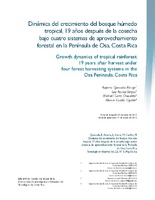Mostrar el registro sencillo del ítem
Dinámica del crecimiento del bosque húmedo tropical, 19 años después de la cosecha bajo cuatro sistemas de aprovechamiento forestal en la Península de Osa, Costa Rica.
| dc.contributor.author | Quesada-Monge, Ruperto | |
| dc.contributor.author | Acosta-Vargas, Luis Guillermo | |
| dc.contributor.author | Garro-Chavarría, Michael | |
| dc.contributor.author | Castillo-Ugalde, Marvin | |
| dc.date.accessioned | 2015-05-04T21:15:50Z | |
| dc.date.available | 2015-05-04T21:15:50Z | |
| dc.date.issued | 2012 | |
| dc.identifier.uri | https://hdl.handle.net/2238/5845 | |
| dc.description | Artículo | es |
| dc.description.abstract | Within the project “Monitoring of forest ecosystems to strengthen conservation strategies and forest use: a contribution to Costa Rica carbon neutral initiative”, the dynamic growth of the tropical rainforest was studied, nineteen years after harvest under four systems of forest use. Through the measurement of all trees (d ≥ 10 cm), three revenue sites were botanically identified in the Peninsula de Osa (Estero Guerra, Dos Brazos de Río Rincón and Los Mogos). Four permanent sampling parcels (PPM) of 1 HA were installed in 1990. At that time and subsequently, fifteen and nineteen years later (2007 and 2011, respectively), the status of the primary forest was examined after applying four logging systems: oxen harvesting system (SACB), improved harvesting system (SATM), traditional harvesting system (SATT) and oxen-tractor system (SABT). The analysis of the forest dynamic was made based on growth, mortality, recruitment and replacement rate. The current annual increment (ICA) average for the period under review ranged from 2,47 to 3,56 mm / year. Statistical analysis showed that the ICA value has a normal distribution and homoscedasticity and the analysis of variance indicated no significant differences between the ICA of each logging system (p = 0,3410). The average mortality rate of the four logging systems is 1,301%, the recruitment rate is 1,869%. The annual turnover rate is 0,569%. Statistical analysis found that mortality; recruitment and replacement rates show a normal distribution and homoscedasticity. On the other hand, analysis of variance showed that differences between the different logging systems are not significant (mortality: P = 0,2412; recruitment: p = 0,0675; parts: p = 0,1159). Paired t tests showed that the mortality and recruitment rates are statistically the same within each logging (SACB: p = 0,4992; SATM: p = 0,9238; SATT: p = 0,9080; SABT: p = 0,8065), confirming the dynamic equilibrium of the forests under study. | es |
| dc.description.sponsorship | Instituto Tecnológico de Costa Rica. | es |
| dc.language.iso | es | es |
| dc.publisher | Instituto Tecnológico de Costa Rica. | es |
| dc.subject | Aprovechamiento | es |
| dc.subject | Dinámica | es |
| dc.subject | Crecimiento | es |
| dc.subject | Mortalidad | es |
| dc.subject | Reclutamiento | es |
| dc.subject | Estudio | es |
| dc.title | Dinámica del crecimiento del bosque húmedo tropical, 19 años después de la cosecha bajo cuatro sistemas de aprovechamiento forestal en la Península de Osa, Costa Rica. | es |
| dc.type | info:eu-repo/semantics/report | es |
Ficheros en el ítem
Este ítem aparece en la(s) siguiente(s) colección(ones)
-
Artículos [36]


